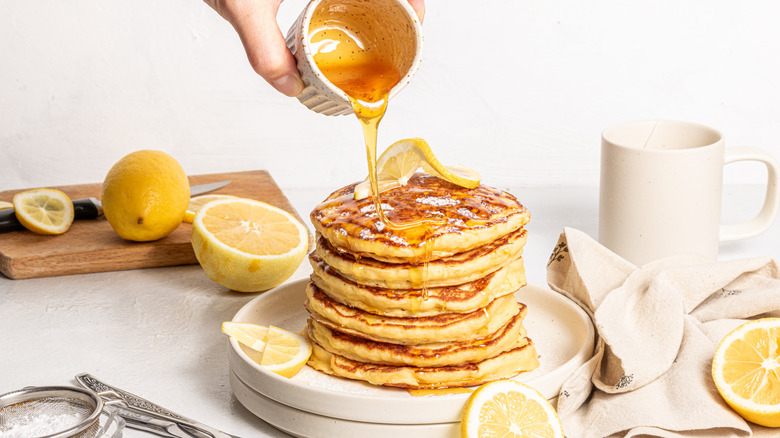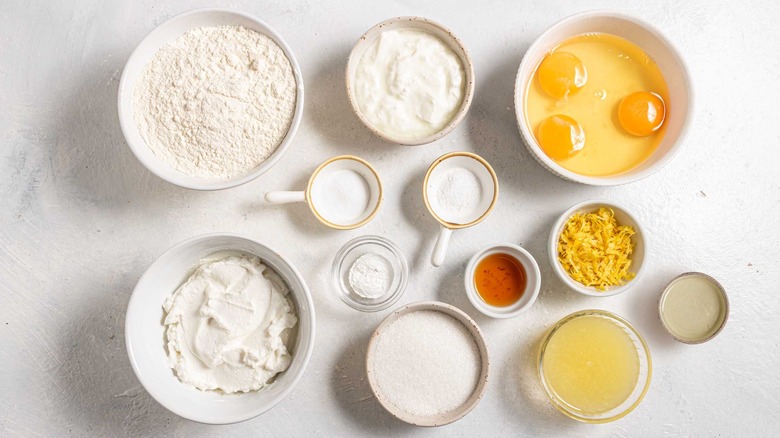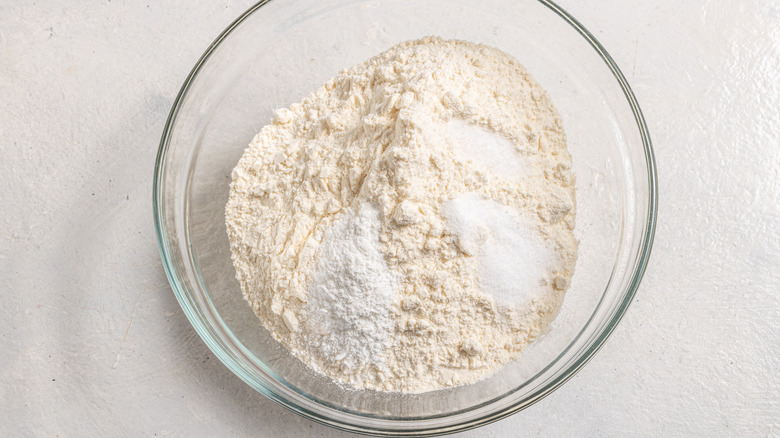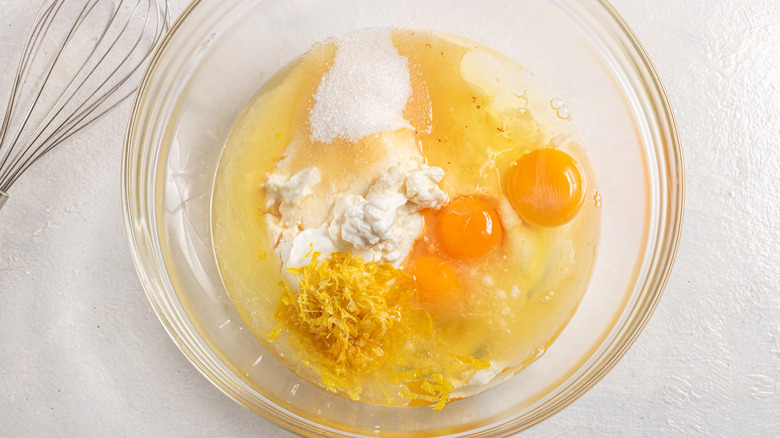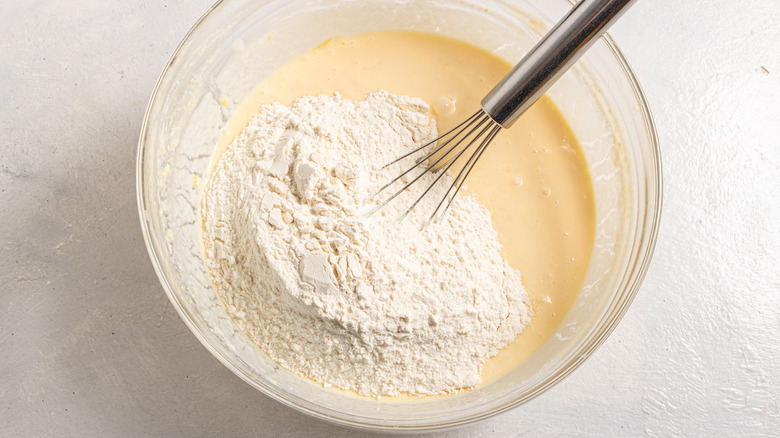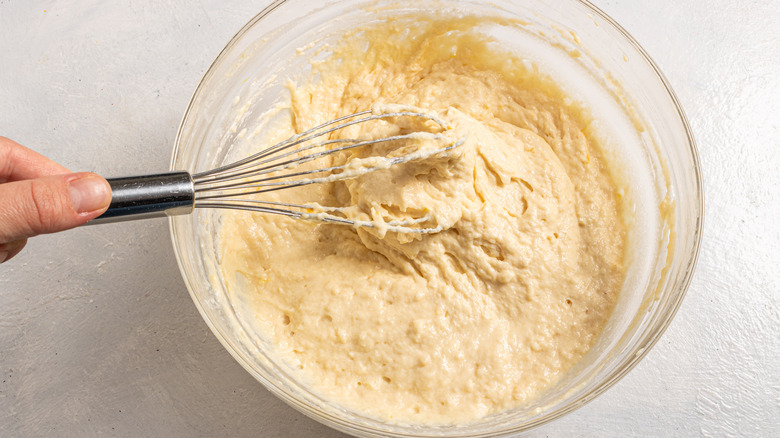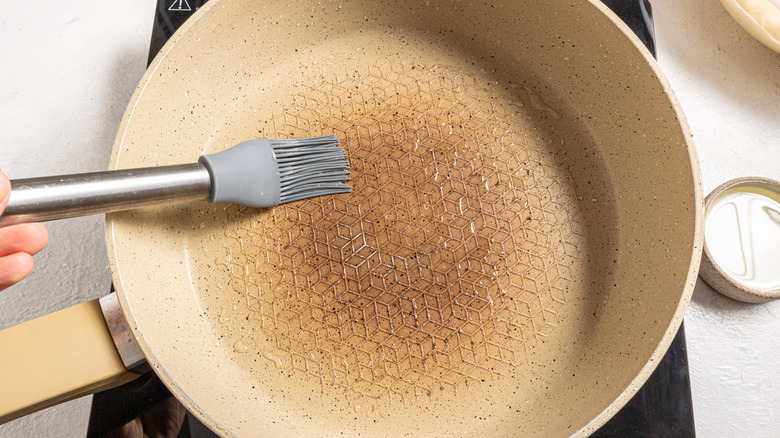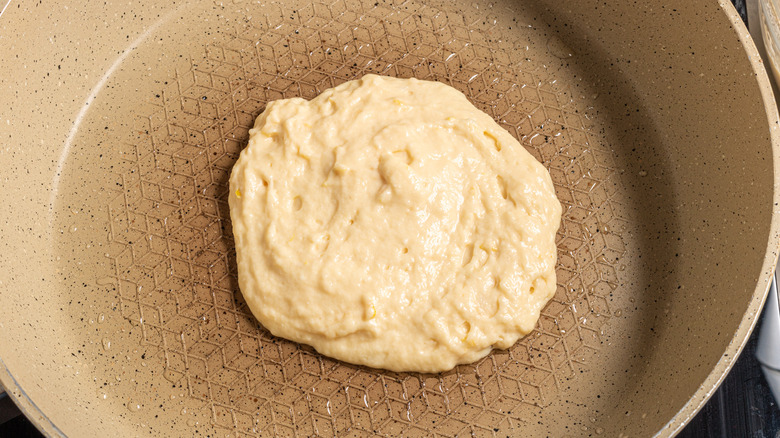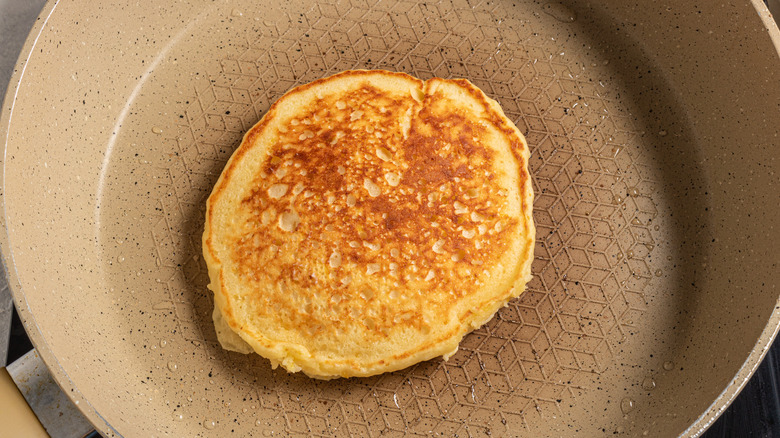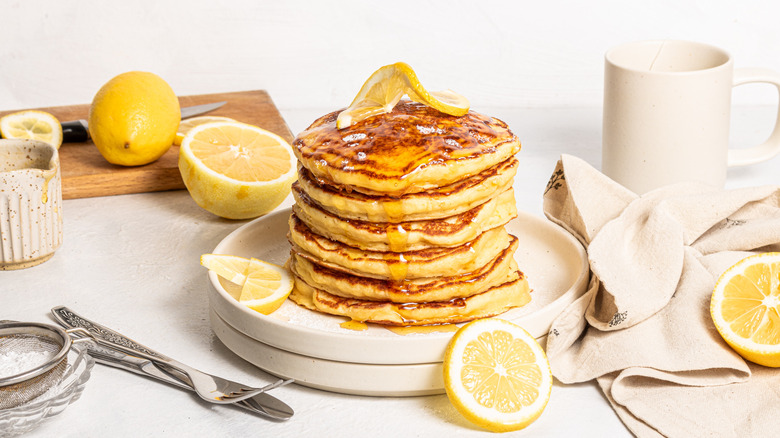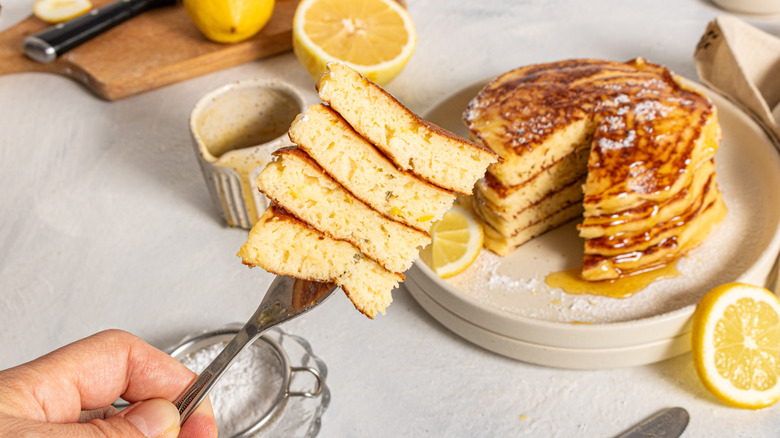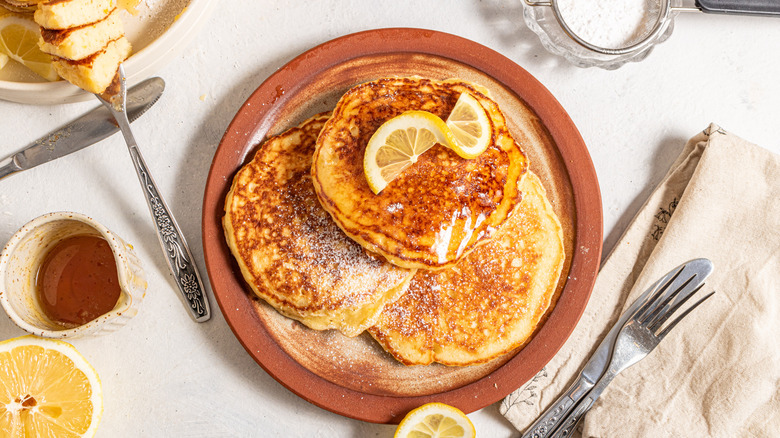Vibrant Lemon Ricotta Pancakes Recipe
This recipe for lemon ricotta pancakes from recipe developer Milena Manolova combines the zesty vibrance of fresh lemon with the rich, luxurious texture of ricotta cheese. The result? A deliciously light and tender pancake. This recipe calls for yogurt instead of milk or buttermilk, which not only adds moisture to the batter but also imparts a tangy flavor that complements the tartness of the lemon and the creaminess of the ricotta cheese.
Simple enough for every day, these unique and easy-to-make pancakes are also perfect as a seriously good way to upgrade a lazy weekend brunch, especially if you dress them up with a few additions or toppings. Add in your favorite fruits: Blueberries, raspberries, strawberries, and even dark sweet cherries would pair well with the bright citrus flavor. You could also add chocolate chips or poppy seeds for a different twist — the possibilities are endless! With their soft and fluffy texture, perfectly balanced flavors, and endless customization options, these lemon ricotta pancakes might become part of your breakfast repertoire.
Gather all the ingredients for the lemon ricotta pancakes recipe
Here is what you need to make these lemon ricotta pancakes: all-purpose flour, baking powder, baking soda, salt, plain yogurt, ricotta cheese, eggs, granulated sugar, vanilla extract, lemon zest, lemon juice, and vegetable oil or butter for brushing the skillet.
Step 1: Combine the dry ingredients
In a bowl, combine the flour, baking powder, baking soda, and salt.
Step 2: Whisk the remaining ingredients
In a separate bowl, whisk the yogurt, ricotta cheese, eggs, sugar, vanilla, lemon zest, and lemon juice, until smooth.
Step 3: Combine the wet and dry ingredients
Add the flour mixture to the wet ingredients.
Step 4: Mix until no dry patches remain
Mix just until the batter is smooth and no dry patches remain.
Step 5: Grease a skillet
Brush some oil or butter onto a skillet on medium heat.
Step 6: Add some of the batter to the hot skillet
Add 2-3 heaping tablespoons of the pancake batter. Cook for about 2 minutes on each side, or until golden brown and cooked through.
Step 7: Cook the pancakes
Repeat with the rest of the batter.
Step 8: Serve and enjoy!
Serve with your favorite toppings.
Vibrant Lemon Ricotta Pancakes Recipe
Ricotta cheese and yogurt make these pancakes tender, moist, and fluffy, and the zest and juice of a fresh lemon gives them a bright, citrusy tanginess.
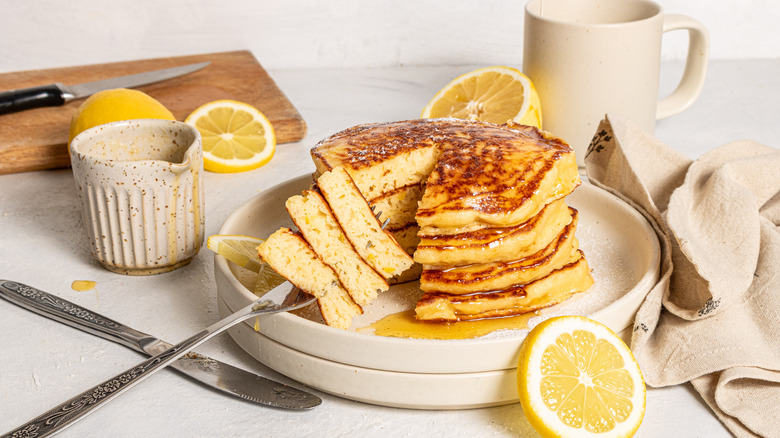
Ingredients
- 2 cups all-purpose flour
- 1 teaspoon baking powder
- ½ teaspoon baking soda
- ¼ teaspoon salt
- ½ cup plain yogurt
- 1 cup ricotta cheese
- 3 large eggs
- ⅓ cup granulated sugar
- 2 teaspoons vanilla extract
- 2 tablespoons lemon zest
- ⅓ cup lemon juice
- 1 tablespoon vegetable oil or butter
Directions
- In a bowl, combine the flour, baking powder, baking soda, and salt.
- In a separate bowl, whisk the yogurt, ricotta cheese, eggs, sugar, vanilla, lemon zest, and lemon juice, until smooth.
- Add the flour mixture to the wet ingredients.
- Mix just until the batter is smooth and no dry patches remain.
- Brush some oil or butter onto a skillet on medium heat.
- Add 2-3 heaping tablespoons of the pancake batter. Cook for about 2 minutes on each side, or until golden brown and cooked through.
- Repeat with the rest of the batter.
- Serve with your favorite toppings.
Nutrition
| Calories per Serving | 200 |
| Total Fat | 6.0 g |
| Saturated Fat | 2.5 g |
| Trans Fat | 0.1 g |
| Cholesterol | 69.5 mg |
| Total Carbohydrates | 29.2 g |
| Dietary Fiber | 0.8 g |
| Total Sugars | 7.8 g |
| Sodium | 212.5 mg |
| Protein | 6.8 g |
Can these pancakes be made gluten-free or dairy-free?
Lemon ricotta pancakes can be customized to accommodate various dietary preferences. For a gluten-free option, use a gluten-free flour blend in place of regular flour. Look for a blend that includes a mix of flours like rice flour, tapioca starch, and potato starch, which will help to create a light and fluffy texture in your pancakes. When using gluten-free flour, check if it has xanthan gum, if it doesn't, then add it yourself, as it can help to bind the ingredients together and give the pancakes structure. Gluten-free batters can sometimes be a bit thicker than regular batters. Letting pancake batter rest for 10-15 minutes before cooking will help to hydrate the flour and create a smoother texture (whether the batter is gluten-free or not). Gluten-free pancakes can be a bit more delicate than regular pancakes, so cooking them on a lower heat will help to prevent burning and create a more evenly cooked pancake.
The acidity in yogurt works as a replacement for buttermilk in the recipe and helps to activate the baking soda, resulting in light and fluffy pancakes. You can easily switch it out for a dairy-free version. Similarly, you can buy or make dairy-free ricotta cheese, such as cashew ricotta, to add tender creaminess without the dairy. To make the pancakes vegan, you can choose from a variety of egg substitutes, ranging from bananas to nut butter.
What does adding ricotta cheese do to pancakes?
When you add ricotta cheese to pancakes you enhance their texture, flavor, and nutritional value. It adds moisture and richness to the batter, resulting in a fluffy and tender crumb. Ricotta cheese has a mild, slightly sweet taste that adds a subtle depth of flavor to your pancakes. It's also a good source of protein, which can help make pancakes more satisfying. Since ricotta cheese adds volume to the batter, it can be used to replace some of the flour in the pancake recipe, making it lighter and more delicate.
If you don't have ricotta cheese on hand or are looking for a different flavor profile, you can substitute cottage cheese, sour cream, or mascarpone cheese. These ingredients will add creaminess and richness, but keep in mind that any of these substitutions will, more or less, affect the texture and flavor of the pancakes, which are likely to be less fluffy but with a tangier flavor than pancakes made with ricotta. You might need to adjust the amount of flour or yogurt in the recipe. Don't be afraid to experiment and find the right balance.
